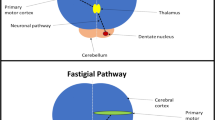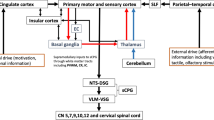Abstract
OBJECTIVE: This study investigated the characteristics of cerebral oxygenation changes in eating disorders patients (ED) and normal controls during the cognitive tasks, using a highly time-resolved, and non-invasive instrument. METHOD: Eleven female patients with anorexia nervosa or bulimia nervosa were recruited, and 11 healthy females participated. The relative concentrations of oxy-hemoglobin [o-Hb] and deoxy-hemoglobin [d-Hb] were measured during word fluency task using multichannel near infrared spectroscopy (NIRS). RESULTS: The increases of o-Hb and d-Hb during the task were compared between the groups. ED patients showed lower activation and a gradual increase in o-HB during the task. In the frontal, d-HB concentrations decreased during the task in ED patients. CONCLUSION: These specific patterns of oxygenation changes may indicate less supply and less demand of cerebral blood volume. Bedside measurements of cerebral oxygenation changes using NIRS are useful on understanding of neurophysiological features of ED.
Similar content being viewed by others
References
Katzman D.K., Lambe E.K., Mikulis D.J., Ridgley J.N., Goldbloom D.S., Zipursky R.B.: Cerebral gray matter and white matter volume deficits in adolescent females with anorexia nervosa. J Pediatr., 129, 794–803, 1996.
Lambe E.K., Katzman D.K., Mikulis D.J., Kennedy S.H., Zipursky R.B.: Cerebral gray matter volume deficits after weight recovery from anorexia nervosa. Arch. Gen. Psychiatry., 54, 537–542, 1997.
Ellison Z., Foong J., Howard R., Bullmore E., Williams S., Treasure J.: Functional anatomy of calorie fear in anorexia nervosa. Lancet., 352, 1192, 1998.
Seeger G., Braus D.F., Ruf M., Goldberger U., Schmidt M.H.: Body image distortion reveals amygdala activation in patients with anorexia nervosa — a functional magnetic resonance imaging study. Neurosci. Let., 326, 25–28, 2002.
Santel S., Baving L., Krauel K., Munte T.F., Rotte M.: Hunger and satiety in anorexia nervosa: fMRI during cognitive processing of food pictures. Brain Res., 1114, 138–148, 2006.
Uher R., Murphy T., Friederich H.C., Dalgleish T., Brammer M.J., Giampietro V., Phillips M.L., Andrew C.M., Ng V.W., Williams S.C., Campbell I.C., Treasure J.: Functional neuroanatomy of body shape perception in healthy and eating-disordered women. Biol. Psychiatry, 58, 990–997, 2005.
Uher R., Murphy T., Brammer M.J., Dalgleish T., Phillips M.L., Ng V.W., Andrew C.M., Williams S.C., Campbell I.C., Treasure J.: Medial prefrontal cortex activity associated with symptom provocation in eating disorders. Am. J. Psychiatry, 161, 1238–1246, 2004.
Frank G.K., Wagner A., Achenbach S., McConaha C., Skovira K., Aizenstein H., Carter C.S., Kaye W.H.: Altered brain activity in women recovered from bulimic- type eating disorders after a glucose challenge: a pilot study. Int. J. Eat. Disord., 39, 76–79, 2006.
Gordon C.M., Dougherty D.D., Fischman A.J., Emans J., Grace E., Lamm R., Alpert N.M., Majzoub J.A., Rauch S.L.: Neural substrates of anorexia nervosa: A behavioral challenge study with positron emission tomography. J Pediatr., 139, 51–57, 2001.
Naruo T., Nakabeppu Y., Sagiyama K., Munemoto T., Homan N., Deguchi D., Nakao M., Nozoe S.: Characteristic regional cerebral blood flow patterns in anorexia nervosa patients with binge/purge behavior. Am. J. Psychiatry, 157, 1520–1522, 2000.
Wu J.C., Hagmann J., Buchsbaum M.S., Blinder B., Derrfler M., Tai W.Y., Hazlett E., Sicotte N.: Greater left cerebral hemispheric metabolism in bulimia assessed by positron emission tomography. Am. J. Psychiatry, 147, 309–312, 1990.
Ferro A.M., Brugnolo A., De Leo C., Dessi B., Girtler N., Morbelli S., Nobili F., Rossi D.S., Falchero M., Murialdo G., Rossini P.M., Babiloni C., Schizzi R., Padolecchia R., Rodriguez G.: Stroop interference task and single-photon emission tomography in anorexia: a preliminary report. Int. J. Eat. Disord., 38, 323–329, 2005.
Fassino S., Piero A., Daga G.A., Leombruni P., Mortara P., Rovera G.G.: Attentional biases and frontal functioning in anorexia nervosa. Int. J. Eat. Disord., 31, 274–283, 2002.
Mathias J.L., Kent P.S.: Neuropsychological consequences of extreme weight loss and dietary restriction in patients with anorexia nervosa. J. Clin. Exp. Neuropsychol., 20, 548–564, 1998.
Jobsis F.F.: Noninvasive infrared monitoring of cerebral and myocardial oxygen sufficiency and circulatory parameters. Science, 198, 1264–1267, 1977.
Hoshi Y.: Functional near-infrared optical imaging: utility and limitations in human brain mapping. Psychophysiology, 40, 511–520, 2004.
Matsuo K., Watanabe A., Onodera Y., Kato N., Kato T.: Prefrontal hemodynamic response to verbal-fluency task and hyperventilation in bipolar disorder measured by multi-channel near-infrared spectroscopy. J. Affect. Disord., 82, 85–92, 2004.
Mehagnoul-Schipper D.J., van der Kallen B.F.W., Colier W.N.J.M., van der Sluijs M.C., van Erning L.J.T.O., Thijssen H.O.M., Oeseburg B., Hoefnagels W.H., Jansen R.W.: Simultaneous measurements of cerebral oxygenation changes during brain activation by nearinfrared spectroscopy and functional magnetic resonance imaging in healthy young and elderly subjects. Hum. Brain Mapp. 16, 14–23, 2002.
Toronov V., Webb A., Choi J.H., Wolf M., Michalos A., Gratton E., Hueber D.: Investigation of human brain hemodynamics by simultaneous near-infrared spectroscopy and functional magnetic resonance imaging. Med. Phys., 28, 521–527, 2001.
Malonek D., Dirnagl U., Lindauer U., Yamada K., Kanno I., Grinvald A.: Vascular imprints of neuronal activity: relationships between the dynamics of cortical blood flow, oxygenation, and volume changes following sensory stimulation. Proc. Natl. Acad. Sci. U. S. A. 95, 14826–14831, 1997
Strangman G., Culver J.P., Thompson J.H., Boas D.A.: A quantitative comparison of simultaneous BOLD fMRI and NIRS recordings during functional brain activation. NeuroImage 17, 719–731, 2002.
American Psychiatric Association. Diagnostic and Statistical Manual for Mental Disorders 4th ed., Washington DC, APA, 1994.
Suto T., Fukuda M., Ito M., Uehara T., Mikuni M.: Multichannel near-infrared spectroscopy in depression and schizophrenia: cognitive brain activation study. Biol. Psychiatry, 55, 501–511, 2004.
Ito M., Fukuda M., Suto T., Uehara T., Mikuni M.: Increased and decreased cortical reactivities in novelty seeking and persistence: a multichannel nearinfrared spectroscopy study in healthy subjects. Neuropsychobiology, 52, 45–54, 2005.
Kameyama M., Fukuda M., Uehara T., Mikuni M.: Sex and age dependencies of cerebral blood volume changes during cognitive activation: a multichannel near-infrared spectroscopy study. Neuroimage, 22, 1715–1721, 2005.
Kameyama M., Fukuda M., Yamagishi Y., Sato T., Uehara T., Ito M., Suto T., Mikuni M.: Frontal lobe function in bipolar disorder: a multichannel near-infrared spectroscopy study. Neuroimage, 29, 172–184, 2006.
Sato T., Ito M., Suto T., Suda M., Kameyama M., Yamagishi Y., Oshima A., Uehara T., Fukuda M., Mikuni M.: Time courses of brain activation and their implications for function: a multichannel near-infrared spectroscopy study during finger tapping. Neurosci. Res. 58, 297–304, 2007.
Author information
Authors and Affiliations
Corresponding author
Additional information
We made a preliminary presentation of this study at the 13th Congress of the World Psychiatric Association on August 2002 in Yokohama, and introduced the parts of this study at the 1st Asia Pacific Eating Disorders Conference in Melbourne on October 2002.
Rights and permissions
About this article
Cite this article
Uehara, T., Fukuda, M., Suda, M. et al. Cerebral blood volume changes in patients with eating disorders during word fluency: a preliminary study using multi-channel near infrared spectroscopy. Eat Weight Disord 12, 183–190 (2007). https://doi.org/10.1007/BF03327596
Received:
Accepted:
Published:
Issue Date:
DOI: https://doi.org/10.1007/BF03327596




